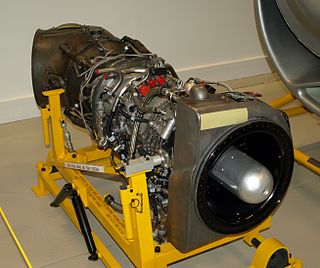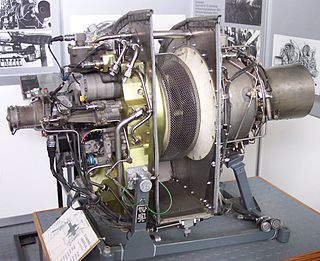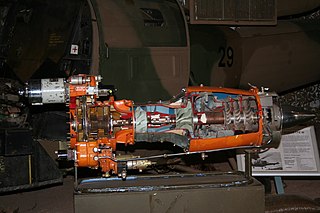Related Research Articles

The Rolls-Royce Turbomeca RTM322 is a turboshaft engine produced by Rolls-Royce Turbomeca Limited, a joint venture between Rolls-Royce plc and Turbomeca. The engine was designed to suit a wide range of military and commercial helicopter designs. The RTM322 can also be employed in maritime and industrial applications.

The Pratt & Whitney Canada PT6 is a turboprop aircraft engine produced by Pratt & Whitney Canada. Its design was started in 1958, it first ran in February 1960, first flew on 30 May 1961, entered service in 1964 and has been continuously updated since. It consists of two basic sections: a gas generator with accessory gearbox and a free power turbine with reduction gearbox, and is often seemingly mounted backwards in an aircraft in so far as the intake is at the rear and the exhaust at the front. Many variants of the PT6 have been produced, not only as turboprops but also as turboshaft engines for helicopters, land vehicles, hovercraft, and boats; as auxiliary power units; and for industrial uses. By November 2015, 51,000 had been produced, had logged 400 million flight hours from 1963 to 2016. It is known for its reliability with an in-flight shutdown rate of 1 per 651,126 hours in 2016. The PT6A covers the power range between 580 and 1,940 shp while the PT6B/C are turboshaft variants for helicopters.

The MTU Turbomeca Rolls-Royce MTR390 is a turboshaft developed for light helicopter applications by MTU Turbomeca Rolls-Royce (MTR). The engine is designed to power helicopters in the weight range of 5-7 tonnes in both single and twin engine configurations. So far the only application is the Eurocopter Tiger. Test runs of the MTR390 began in 1989 and the first test flight was performed in 1991. The MTR390 received military certification in May 1996 and civil approval in June 1997.

The Pratt & Whitney Canada PW100 aircraft engine family is a series of 1,800 to 5,000 shaft horsepower turboprops manufactured by Pratt & Whitney Canada. Pratt & Whitney Canada dominates the turboprops market with 89% of the turboprop regional airliner installed base in 2016, leading GE Aviation and Allison Engine Company.

The Bell 427 is a twin-engine, multirole, light utility helicopter designed and manufactured by Bell Helicopter and Samsung Aerospace Industries. It has been replaced in production by the larger Bell 429.
The Turbomeca TM 333 is a turboshaft engine manufactured by French company Turbomeca and designed for helicopters weighing 4-5 tonnes. It first ran in August 1981 and was introduced commercially in the mid 1980s. It was the first Turbomeca engine to use a single stage turbine, making it more compact than its predecessors. In its original design, the engine was rated at 750 continuous horsepower, though it was designed to allow for future power increases, and the later 2B2 variant made 1,100 horsepower.

The Rolls-Royce Gnome is a British turboshaft engine originally developed by the de Havilland Engine Company as a licence-built General Electric T58, an American mid-1950s design. The Gnome came to Rolls-Royce after their takeover of Bristol Siddeley in 1968, Bristol having absorbed de Havilland Engines Limited in 1961.

The Rolls-Royce Gem is a turboshaft engine developed specifically for the Westland Lynx helicopter in the 1970s. The design started off at de Havilland and was passed to Bristol Siddeley as the BS.360. When Rolls-Royce bought out the latter in 1966, it became the RS.360.

The Allison Model 250, now known as the Rolls-Royce M250, is a highly successful turboshaft engine family, originally developed by the Allison Engine Company in the early 1960s. The Model 250 has been produced by Rolls-Royce since it acquired Allison in 1995.

The MD Helicopters MD Explorer is a light twin utility helicopter. Designed in the early 1990s by McDonnell Douglas Helicopter Systems, it is currently produced by MD Helicopters. There have been two models, the original MD 900, and its successor, the MD 902.

The General Electric T700 and CT7 are a family of turboshaft and turboprop engines in the 1,500–3,000 shp (1,100–2,200 kW) class.

The Turbomeca Astazou is a highly successful series of turboprop and turboshaft engines, first run in 1957. The original version weighed 110 kg (243 lb) and developed 240 kW (320 shp) at 40,000 rpm. It was admitted for aviation service on May 29, 1961, after a 150-hour test run. The main developing engineer was G. Sporer. It was named after two summits of the Pyrenees.

The Turbomeca Arriel is a series of French turboshaft engines that first ran in 1974. Delivering 650 to 1,000 hp, over 12,000 Arriel engines have been produced from 1978 to 2018, logging more than 50 million flight hours for 40 helicopter applications. In June 2018, 1,000 Arriel 2D were in service, powering H125 and H130 single-engine helicopters, having logged one million flight hours since 2011. After endurance tests and fleet data analysis, their TBO increased by 25% to 5,000 hours and mandatory inspection rose to 15 years with no hourly limit, lowering maintenance costs.

The Turbomeca Arrius is one of a family of turboshaft engines for helicopter use, first produced in 1981. As of 2012, some 2,700 units had been sold. Power ranges between 357 kW and 530 kW for different versions. Following Turbomeca tradition, the Arrius was named after a Pyrenean peak, located in the Ossau Valley near Pau.

The Turbomeca Artouste is an early French turboshaft engine, first run in 1947. Originally conceived as an auxiliary power unit (APU), it was soon adapted to aircraft propulsion, and found a niche as a powerplant for turboshaft-driven helicopters in the 1950s. Artoustes were licence-built by Bristol Siddeley in the UK, Hindustan Aeronautics Limited in India, and developed by Continental CAE in the US as the Continental T51. Two major versions of the Artouste were produced. The Artouste II family, mainly used in the Aérospatiale Alouette II helicopter, had a one-stage centrifugal compressor and a two-stage turbine, with gearbox-limited power of 300 kW (400 hp). The Artouste III family, mainly used in Aérospatiale's Alouette III and Lama helicopters, had a two-stage axial-centrifugal compressor and a three-stage turbine, with gearbox-limited power of 420–440 kW (560–590 hp).

The Turbomeca Makila is a family of French turboshaft engines for helicopter use, first run in 1976 and flown in 1977.

The Safran Ardiden is a 1,400–2,000 hp (1,000–1,500 kW) turboshaft designed and produced by Safran Helicopter Engines for 5–8 t (11,000–18,000 lb) single and twin-engine helicopters. Launched in 2003 as a more powerful TM 333, it first ran in 2005 and was introduced in 2007. The Ardiden 1 Shakti powers the Indian HAL Dhruv, Light Combat Helicopter and Light Utility Helicopter while the more powerful Ardiden 3 powers the Avicopter AC352 and Kamov Ka-62.

The Continental CAE T51 was a small turboshaft engine produced by Continental Aviation and Engineering (CAE) under license from Turbomeca. A development of the Artouste, it was followed by three additional turboshaft engines, the T72, the T65, and the T67. However, none of these engines, including the T51, entered full production. CAE abandoned turboshaft development in 1967 after the XT67 lost to the Pratt & Whitney Canada PT6T (T400) to power the Bell UH-1N Twin Huey.

The AgustaWestland AW109S Grand is a lightweight, twin-engine, eight-seat multi-purpose helicopter built by the Anglo-Italian manufacturer AgustaWestland. This rotorcraft has been developed from AgustaWestland AW109 by lengthening the cabin and main rotor blades with different tip design. The Agusta Grand is fitted with two Pratt & Whitney Canada PW207C engines whereas its predecessor AW109E has two Pratt & Whitney Canada PW206C engines. It originally entered service in 2005 and has since been used in various roles, including light transport, medevac, search-and-rescue, and military roles.
The Safran Arrano is a turboshaft engine for two-to-three ton single-engine and four-to-six ton twin-engine helicopters, developed by Safran Helicopter Engines, outputting 1,100 to 1,300 hp.
References
- ↑ "PW200 - Pratt & Whitney".
- ↑ "Power The Pratt & Whitney Canada Story" Sullivan and Milberry, CANAV Books 1989, ISBN 0-921022-01-8, p.300
- 1 2 3 4 5 6 7 8 9 10 "Type Certificate Data Sheet EA E.017 PW206 & PW207 series engines" (PDF). European Aviation Safety Agency. 28 July 2009. Archived from the original (PDF) on 23 December 2009. Retrieved 2009-12-26.
- ↑ https://www.flightglobal.com/pdfarchive/view/1985/1985%20-%202881.html [ dead link ]
- ↑ "PW210". pwc.ca. Retrieved 11 March 2021.
- ↑ "Gas Turbine Engines. Aviation Week & Space Technology 2009 Source Book. pg. 126". Aviation Week & Space Technology. 2009-01-26. Retrieved 2011-06-30.[ permanent dead link ]
- ↑ "EASA TYPE-CERTIFICATE DATA SHEET" (PDF). EASA. Retrieved 17 March 2019.